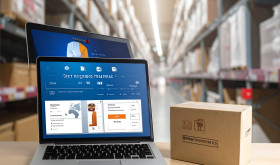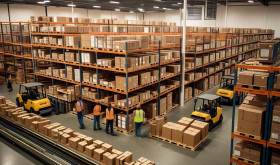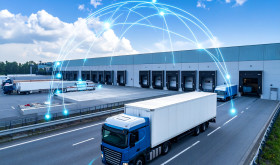
TMS: Streamline Transport, Reduce Costs, Boost Customer Satisfaction
Introduction
Effective transport management system is crucial in today’s ever-changing corporate environment when supply chains span several continents and customer demands are only going to get higher. Route planning, carrier selection, freight auditing, and performance monitoring are just a few of the many transport operations tasks that a Transport Management System (TMS) can streamline and enhance.
Understanding Transport Management System
A TMS is a software that automates and streamlines the planning, execution and tracking of transportation-related tasks in the supply chain. A TMS provides real-time visibility into transportation processes when combined with other systems such as warehouse management systems (WMS) and enterprise resource planning (ERP). This allows companies to optimise their logistics operations and make informed decisions.
Key Features and Functionalities
A reliable TMS usually provides a variety of features and capabilities such as:
- Route Optimisation: helps improve the efficiency of delivery routes to reduce fuel consumption, reduce transportation costs, and speed up deliveries.
- Carrier Management: responsible for negotiating rates, selecting carriers, and monitoring performance in its dealings with carriers.
- Load Planning: arranges cargo in a way that optimises truck capacity and minimises empty miles.
- Shipment Tracking: allows you to manage delays or interruptions in real-time by providing you with real-time data on where and what your shipments are in the route.
- Freight Auditing and Payment: automates freight bill audit and payment to ensure that freight bills are accurate and meet contractual requirements.
- Analytics and Reporting: uses data from the transport sector to identify trends, increase productivity, and support continuous improvements.
Benefits of Implementing a TMS
- Cost Savings and Increased Efficiency
- Optimised Routes and Carrier Selection: A TMS allows you to determine the most cost-effective routes for your shipments by taking into account factors such as distance, traffic volume, and fuel expenses. It also enables you to compare rates between different carriers to get the best price for your needs, which can significantly reduce your transportation costs.
- Reduced Paperwork and Streamlined Processes: Manual processes such as freight bookings, documentation, and invoice reconciliation take up a lot of time and are prone to errors. With a TMS, these processes are automated, and your staff can focus on other important tasks. This leads to increased productivity and lower administrative costs.
- Improved Load Consolidation: A TMS allows you to find ways to combine multiple consignments into fewer trucks, reducing the number of trips you need to make and optimising your transportation assets, saving you money, and reducing your carbon footprint.
- Enhanced Visibility and Control
- Real-Time Tracking and Traceability: Real-time tracking with a TMS gives you real-time insight into where and what your shipments are in the route. This means you’ll be able to address delays and issues in real time and keep your customers in the loop. Better tracking also helps build trust and transparency in your supply chain ecosystem.
- Centralized Data Management: A TMS eliminates the need for spreadsheets and data silos. A TMS provides a central repository for all your transportation data, allowing you to gain insights into your logistics processes. You can easily track key performance indicators (KPIs) like on-time delivery (OTR), carrier performance, and transportation costs.
- Improved Inventory Management: Real-time shipping visibility enables better inventory management and forecasting. With real-time visibility, you can make sure you have the correct quantity in the right place at the correct time, reducing the likelihood of stock shortages and oversupply.
- Improved Customer Service
- Accurate Delivery Time Estimates: A TMS allows you to schedule routes and times more effectively so that customers can get an accurate estimate of delivery times. This transparency increases customer satisfaction and builds brand trust.
- Proactive Exception Management: With real-time monitoring and real-time data analysis, you can anticipate delays or issues before they affect your customers. This allows you to take proactive steps to resolve issues and reduce disruptions to deliver faster.
- Enhanced Communication: A TMS enables your company, carriers, and customers to communicate more effectively. Customers can easily monitor their shipments online and receive alerts in the event of shipment delays. This improves communication and enhances customer satisfaction.
- Scalability and Growth
- Adaptability to Changing Needs: A TMS can be easily scaled to accommodate the growing needs of your business expansion. As your shipment volume increases or your business expands geographically, your TMS can adapt and grow with you.
- Integration with Existing Systems: A TMS solution integrates seamlessly with existing business systems like your Enterprise Resource Planning (ERP) or Warehouse Management System (WMS). This eliminates data silos and ensures a smooth flow of information across your entire operation.
- Data-Driven Decision Making: The data insights generated by a TMS empower you to make informed decisions about your transportation operations. You can identify areas for improvement, optimise routes, and negotiate better rates with carriers.
Beyond these core benefits, a TMS can also offer additional advantages depending on your specific industry and needs. For example, a TMS solution offers features like:
- Compliance Management: Ensuring your shipments adhere to all relevant regulations.
- Multi-Modal Transportation Management: Coordinating shipments across different modes of transport (e.g., road, air and sea).
- Fuel Management: Optimising fuel consumption and reducing fuel costs.
Implementing a TMS
Implementing a TMS requires careful planning, collaboration, and investment in technology. The key steps in the implementation process include:
- Assessing Business Needs: This includes an in-depth review of your current transportation operations, identifying bottlenecks and bottlenecks, and setting clear goals for the implementation of a TMS.
- Selecting the Right Solution: This step is to research and choose a TMS that meets your business needs, budget, and scalability requirements.
- Integration with Existing Systems: Connect the TMS to existing systems, including ERP and WMS, to facilitate data flow and interoperability.
- Training and Education: Train and educate employees on how to effectively use the TMS, how to interpret transportation data and how to adapt to new procedures and processes.
- Continuous Improvement: Develop metrics and key performance indicators (KPIs) to track TMS performance, track KPIs like on-time delivery (OTD) and transportation costs and identify areas for improvement.
Conclusion
Y3’s Transport Management System (TMS) is one of the most important tools for any business looking to streamline the transportation process and save money while improving customer satisfaction. With the help of Y3’s TMS, businesses can monitor their transportation expenses in real-time and automate tedious tasks, improving routing and scheduling, thus keeping ahead of the competition. As the business grows and evolves, Y3’s TMS becomes an essential investment that will make the company grow faster and more agile as the times change.










